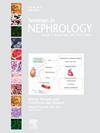Hung Nguyen, Bryan K Becker, Subhashini Bolisetty, Malgorzata Kasztan, Paul W Sanders, Kelly A Hyndman
求助PDF
{"title":"High Environmental Heat Exposure Is a Risk Factor for Acute Kidney Injury and Chronic Kidney Disease.","authors":"Hung Nguyen, Bryan K Becker, Subhashini Bolisetty, Malgorzata Kasztan, Paul W Sanders, Kelly A Hyndman","doi":"10.1016/j.semnephrol.2025.151664","DOIUrl":null,"url":null,"abstract":"<p><p>Chronic kidney disease of unknown etiology has been reported in Mesoamerican regions and other parts of the world, with increasing evidence pointing to heat stress as a central contributing factor. The incidence of acute kidney injury appears to correlate strongly with heat exposure, as demonstrated in both human and animal studies. The underlying mechanisms of heat-induced kidney injury are likely multifactorial, involving hemodynamic changes, immune responses, and possibly coagulopathies. However, the precise pathways remain unclear, highlighting the urgent need for a deeper understanding of the mechanisms and for developing strategies to prevent or mitigate renal damage. This is particularly important not only for heat-exposed occupational groups, such as agricultural workers, military personnel, and athletes, but also for the general population, who are increasingly vulnerable to extreme heat events every year. Semin Nephrol 36:x-xx © 20XX Elsevier Inc. All rights reserved.</p>","PeriodicalId":21756,"journal":{"name":"Seminars in nephrology","volume":" ","pages":"151664"},"PeriodicalIF":3.5000,"publicationDate":"2025-09-05","publicationTypes":"Journal Article","fieldsOfStudy":null,"isOpenAccess":false,"openAccessPdf":"","citationCount":"0","resultStr":null,"platform":"Semanticscholar","paperid":null,"PeriodicalName":"Seminars in nephrology","FirstCategoryId":"3","ListUrlMain":"https://doi.org/10.1016/j.semnephrol.2025.151664","RegionNum":3,"RegionCategory":"医学","ArticlePicture":[],"TitleCN":null,"AbstractTextCN":null,"PMCID":null,"EPubDate":"","PubModel":"","JCR":"Q2","JCRName":"UROLOGY & NEPHROLOGY","Score":null,"Total":0}
引用次数: 0
引用
批量引用
Abstract
Chronic kidney disease of unknown etiology has been reported in Mesoamerican regions and other parts of the world, with increasing evidence pointing to heat stress as a central contributing factor. The incidence of acute kidney injury appears to correlate strongly with heat exposure, as demonstrated in both human and animal studies. The underlying mechanisms of heat-induced kidney injury are likely multifactorial, involving hemodynamic changes, immune responses, and possibly coagulopathies. However, the precise pathways remain unclear, highlighting the urgent need for a deeper understanding of the mechanisms and for developing strategies to prevent or mitigate renal damage. This is particularly important not only for heat-exposed occupational groups, such as agricultural workers, military personnel, and athletes, but also for the general population, who are increasingly vulnerable to extreme heat events every year. Semin Nephrol 36:x-xx © 20XX Elsevier Inc. All rights reserved.
高环境热暴露是急性肾损伤和慢性肾脏疾病的危险因素。
在中美洲地区和世界其他地区已经报道了病因不明的慢性肾脏疾病,越来越多的证据表明热应激是一个主要的促成因素。急性肾损伤的发生率似乎与热暴露密切相关,正如在人类和动物研究中所证明的那样。热致肾损伤的潜在机制可能是多因素的,包括血流动力学改变、免疫反应和可能的凝血功能障碍。然而,确切的途径仍然不清楚,强调迫切需要更深入地了解机制和制定策略来预防或减轻肾脏损害。这不仅对暴露于高温的职业群体,如农业工人、军事人员和运动员,而且对每年越来越容易受到极端高温事件影响的普通人群尤其重要。Semin Nephrol 36:x-xx©20XX Elsevier Inc.。版权所有。
本文章由计算机程序翻译,如有差异,请以英文原文为准。

 求助内容:
求助内容: 应助结果提醒方式:
应助结果提醒方式:


